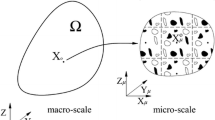Abstract
The present study deals with the formulation of minimal loading conditions for microscale applications in numerical two-scale modelling (FE2) approaches. From the homogenisation concept, a set of volume average rules constrains the microscale PDE to be solved. They are considered to be the minimal set of loading conditions and can be specified by additional polynomial or periodic assumptions, for example, on the microscale displacement field. Whereas the resulting volume integrals can be transformed into surface integrals for so-called first-order homogenisation schemes, this is not possible for a second-order homogenisation of second gradient or micromorphic effective media substituting a heterogeneous microcontinuum represented by a volume element on the microscale. Several numerical examples compare the minimal loading condition concept with standard techniques discussed in literature.
Similar content being viewed by others
References
Aşkar A., Çakmak A.S.: A structural model of a micropolar continuum. Int. J. Eng. Sci. 6, 583–589 (1968)
Diebels S., Steeb H.: The size effect in foams and its theoretical and numerical investigation. Proc. R. Soc. Lond. A 458, 2869–2883 (2002)
Eringen A.C., Suhubi E.S.: Nonlinear theory of simple micro-elastic solids—I. Int. J. Eng. Sci. 2, 189–203 (1964)
Feyel F., Chaboche J.L.: FE2 multiscale approach for modelling the lastoviscoplastic behaviour of long fiber SiC/Ti composite materials. Comp. Meth. Appl. Mech. Eng. 183, 309–330 (2000)
Forest S.: Homogenization methods and the mechanics of generalized continua—part 2. Theor. Appl. Mech. 28–29, 113–143 (2002)
Forest S.: Nonlinear microstrain theories. Int. J. Solids Struct. 43, 7224–7245 (2006)
Forest S.: Micromorphic approach for gradient elasticity, viscoplasticity, and damage. J. Eng. Mech. 135(3), 117–131 (2009)
Forest S., Sab K.: Cosserat overall modeling of heterogeneous materials. Mech. Res. Commun. 25, 449–454 (1998)
Forest S., Trinh D.K.: Generalized continua and non-homogeneous boundary conditions in homogenization methods. Z. Angew. Math. Mech. 90(2), 90–109 (2011)
Germain P.: The method of virtual power in continuum mechanics. Part 2: microstructure. SIAM J. Appl. Math. 25, 556–575 (1973)
Hain M., Wriggers P.: Numerical homogenization of hardened cement paste. Comp. Mech. 42, 197–212 (2008)
Hill R.: Elastic properties of reinforced solids: some theoretical principles. J. Mech. Phys. Solids 11, 357–372 (1963)
Jänicke, R.: Micromorphic Media: Interpretation by Homogenisation. PhD-thesis. Saarbrücker Reihe Materialwissenschaft und Werkstofftechnik, Band 21, Shaker Verlag, Aachen. http://scidok.sulb.uni-saarland.de/volltexte/2010/3209 (2010)
Jänicke R., Diebels S.: Requirements on periodic micromorphic media. In: Maugin, G.A., Metrikine, A. (eds) Mechanics of generalized continua, pp. 99–108. Springer, Berlin (2010)
Jänicke R., Diebels S., Sehlhorst H.G., Düster A.: Two-scale modelling of micromorphic continua. Cont. Mech. Therm. 21(4), 297–315 (2009)
Kaczmarczyk L., Pearce C.J., Bićanić N.: Scale transition and enforcement of RVE boundary conditions in second-order homogenization. Int. J. Numer. Meth. Eng. 74, 506–522 (2008)
Kouznetsova, V.G., Brekelmans, W.A.M., Baaijens, F.P.T.: An approach to micro-macro modeling of heterogeneous materials. Comp. Mech., 37–48 (2001)
Kouznetsova V.G., Geers M.G.D., Brekelmans W.A.M.: Multi-scale constitutive modelling of heterogeneous materials with a gradient-enhanced computational homogenization scheme. Int. J. Numer. Meth. Eng. 54, 1235–1260 (2002)
Kouznetsova, V.G., Geers, M.G.D., Brekelmans, W.A.M.: Size of a representative volume element in a second-order computational homogenization framework. Int. J. Multiscale Comput. Eng., 575–598 (2004)
Maugin G.A.: Material Inhomogeneities in Elasticity. CRC Press, Boca Raton (1993)
Mesarovic S., Padbidri J.: Minimal kinematic boundary conditions for simulations of disordered microstructures. Phil. Mag. 85(1), 65–78 (2005)
Miehe C.: Numerical computation of algorithmic (consistent) tangent moduli in large-strain computational inelasticity. Comp. Meth. Appl. Mech. Eng. 134, 223–240 (1996)
Mindlin R.D.: Micro-structure in linear elasticity. Arch. Rat. Mech. Anal. 16, 51–78 (1964)
Mindlin R.D.: Second gradient of strain and surface tension in linear elasticity. Int. J. Solids Struct. 1, 417–438 (1965)
Nemat-Nasser S., Hori M.: Micromechanics. North-Holland, Amsterdam (1993)
Phani A.S., Woodhouse J., Fleck N.A.: Wave propagation in two-dimensional periodic lattices. J. Acoust. Soc. Am. 119(4), 1995–2005 (2006)
Schröder, J.: Homogenisierungsmethoden der nichtlinearen Kontinuumsmechanik unter Beachtung von Stabilitätsproblemen. Habilitationsschrift, Institut für Mechanik (Bauwesen), Lehrstuhl I, Universität Stuttgart (2000)
Swan C.C.: Techniques for stress-controlled and strain-controlled homogenization of inelastic periodic composites. Comp. Meth. Appl. Mech. Eng. 117, 249–267 (1994)
Tekoǧlu C., Onck P.R.: Size effects in the mechanical behaviour of cellular materials. J. Mat. Sci. 40, 3564–5911 (2005)
Trinh, D.K., Jänicke, R., Auffray, N., Diebels, S., Forest, S.: Evaluation of generalized continuum substitution models for heterogeneous materials. Int J Multiscale Comput. Eng. (accepted for publication) (2011)
Author information
Authors and Affiliations
Corresponding author
Rights and permissions
About this article
Cite this article
Jänicke, R., Steeb, H. Minimal loading conditions for higher-order numerical homogenisation schemes. Arch Appl Mech 82, 1075–1088 (2012). https://doi.org/10.1007/s00419-012-0614-8
Received:
Accepted:
Published:
Issue Date:
DOI: https://doi.org/10.1007/s00419-012-0614-8




